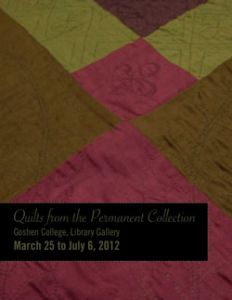Quilts ranging from Hutterite to Navajo on display in Good Library Gallery, March 25-July 6

GOSHEN, Ind. – A variety of quilts from the Mennonite Historical Library from Mennonite, Amish, Hutterite and Native American communities that have been recently acquired or never before exhibited will be on display in the “Quilts from the Permanent Collection” exhibit in Goshen College’s Good Library Gallery from March 25 to July 6. There will be an opening reception on Sunday, March 25 from 3 to 5 p.m. The exhibit and reception are free and open to the public.
More than just beautiful to look at, “Quilts from the Permanent Collection” contains quilts that are just as interesting and important for what they reveal about the people and the cultures from which they come, representing a wide range of communities. The quilts also include documentation with information about the makers, their denominations and communities, as well as non-quilt items that add background and context to the quilts. This collection places special interest in friendship quilts and quilts with messages, to reflect the people and values that lie behind the quilts.
Notable items in the exhibit, which is sponsored by the Mennonite-Amish Museum Committee, include: two Amish diamond-in-the-square quilts from Lancaster County; patchwork privy bags by Amish women from Lancaster County, used to take personal items with them to outdoor toilets; costume items whose colors and materials match those found in Amish, Navajo and Hutterite quilts; and commemorative, friendship and other patchwork and appliquŽd quilts.
A special set of quilts in the exhibit consists of four early crazy-patch quilts with origins in Elkhart County. The oldest is dated 1899 and was made by Magdalena Christner from the Amish community near Millersburg. Three of the crazy-patch quilts are also friendship quilts, with names of friends and relatives embroidered on the patches. One from 1901 was made in Elkhart by cousins of Barbara Coffman, daughter of John S. Coffman, founder of the Elkhart Institute, which became Goshen College in 1903. Another was made in 1929 by neighbors and relatives near Wakarusa for Bertha Weldy Harter’s 29th birthday. And another one from 1921 was made by neighbors for Ira and Erma Loucks Christophel of the Yellow Creek area after their house burned down.
The exhibit was mounted by Melissa Kauffman, a senior art major. “Since my first year of college, I have been interested in working with the Mennonite Historical Society’s exhibits in the library, so I was excited to have the opportunity to curate the spring quilt exhibit,” said Kauffman. “The different quilt styles have made designing the exhibit challenging, but also exciting. I have enjoyed learning more about the quilting tradition of the Mennonite, Amish, Hutterite and Navajo communities.”
The Good Library Gallery, located on the lower level of the Harold and Wilma Good Library on the campus of Goshen College, is open from 8 a.m. to 11 p.m. on Monday through Thursday, 8 a.m. to 5 p.m. on Friday, 1 to 5 p.m. on Saturday and 3 to 11 p.m. on Sunday. Hours vary during academic breaks, summer and holidays. For gallery hours, call (574) 535-7418.
Editors: For more information about this release, to arrange an interview or request a photo, contact Goshen College Acting News Bureau Coordinator Alysha Bergey Landis at (574) 535-7762 or alyshabl@goshen.edu.
###
Goshen College, established in 1894, is a residential Christian liberal arts college rooted in the Anabaptist-Mennonite tradition. The college’s Christ-centered core values – passionate learning, global citizenship, compassionate peacemaking and servant-leadership – prepare students as leaders for the church and world. Recognized for its unique Study-Service Term program, Goshen has earned citations of excellence in Barron’s Best Buys in Education, “Colleges of Distinction,” “Making a Difference College Guide” and U.S.News & World Report‘s “America’s Best Colleges” edition, which named Goshen a “least debt college.” Visit www.goshen.edu.




